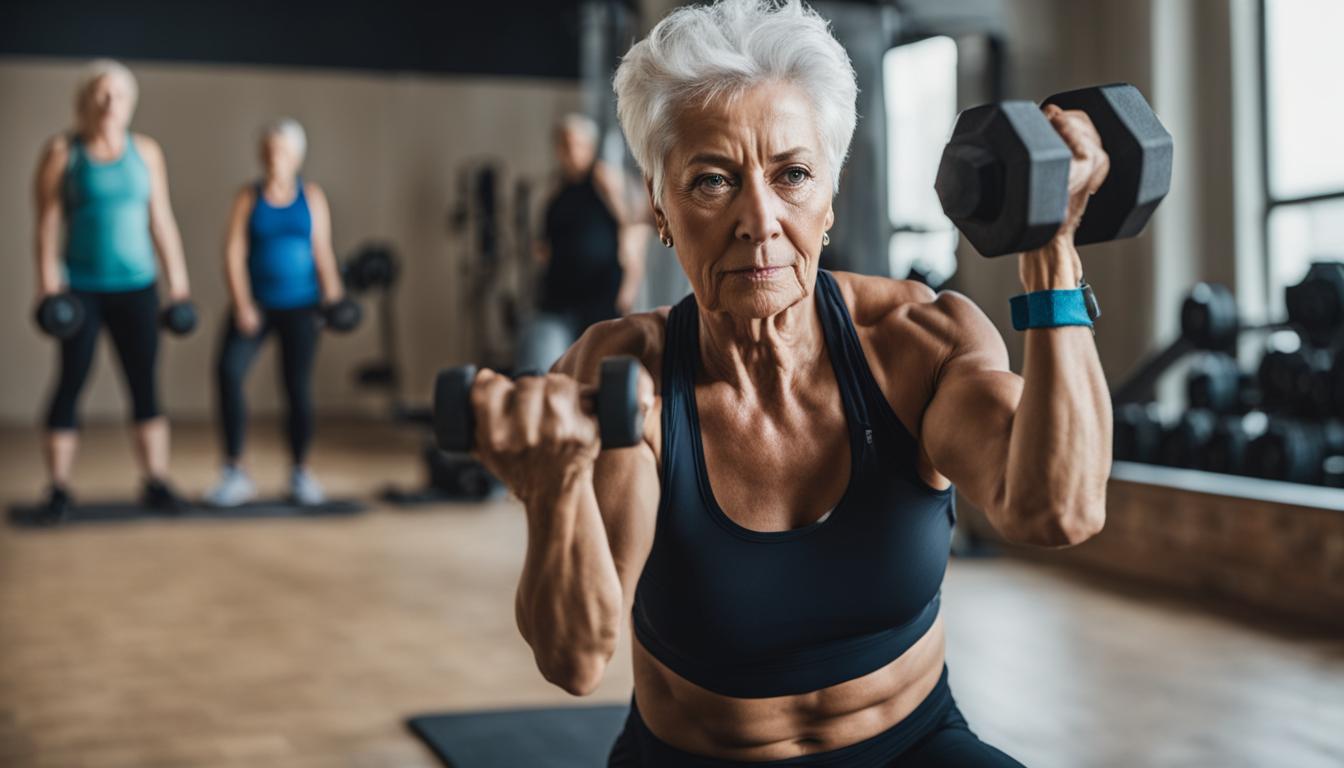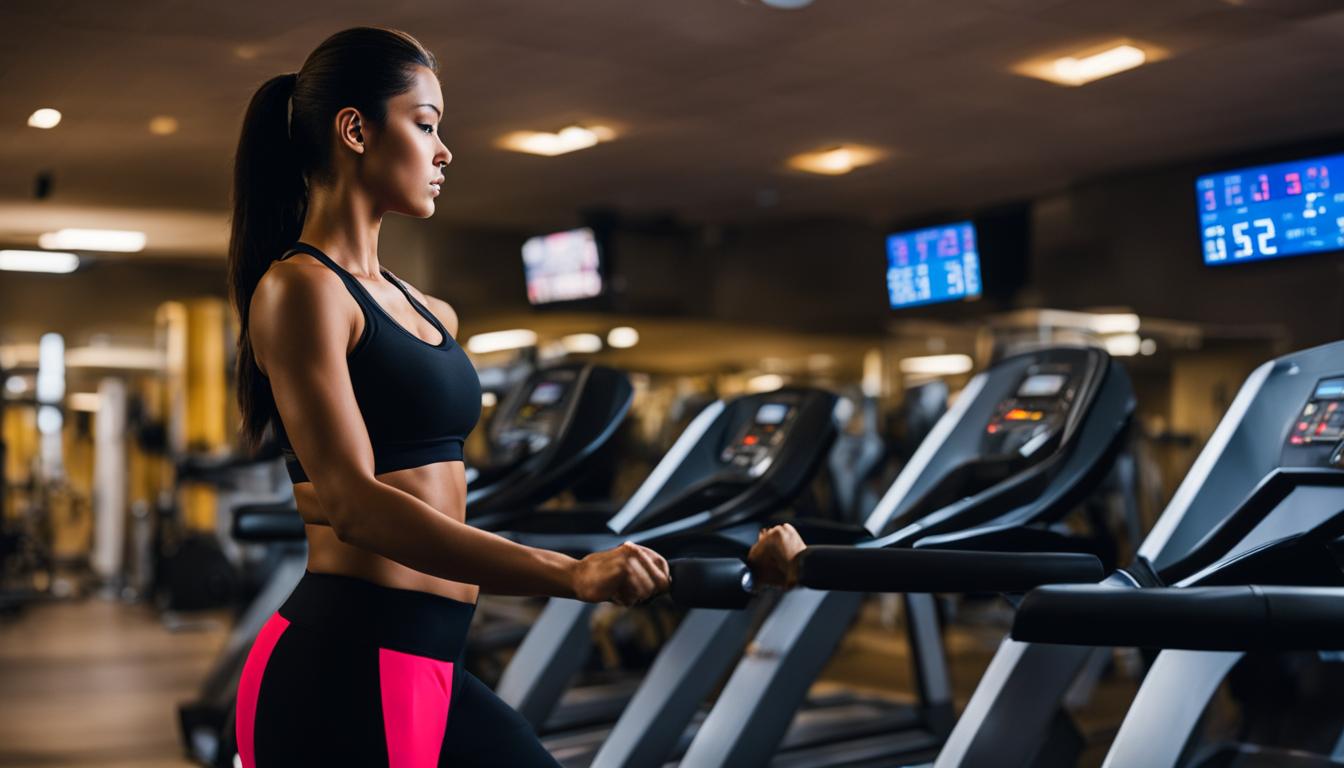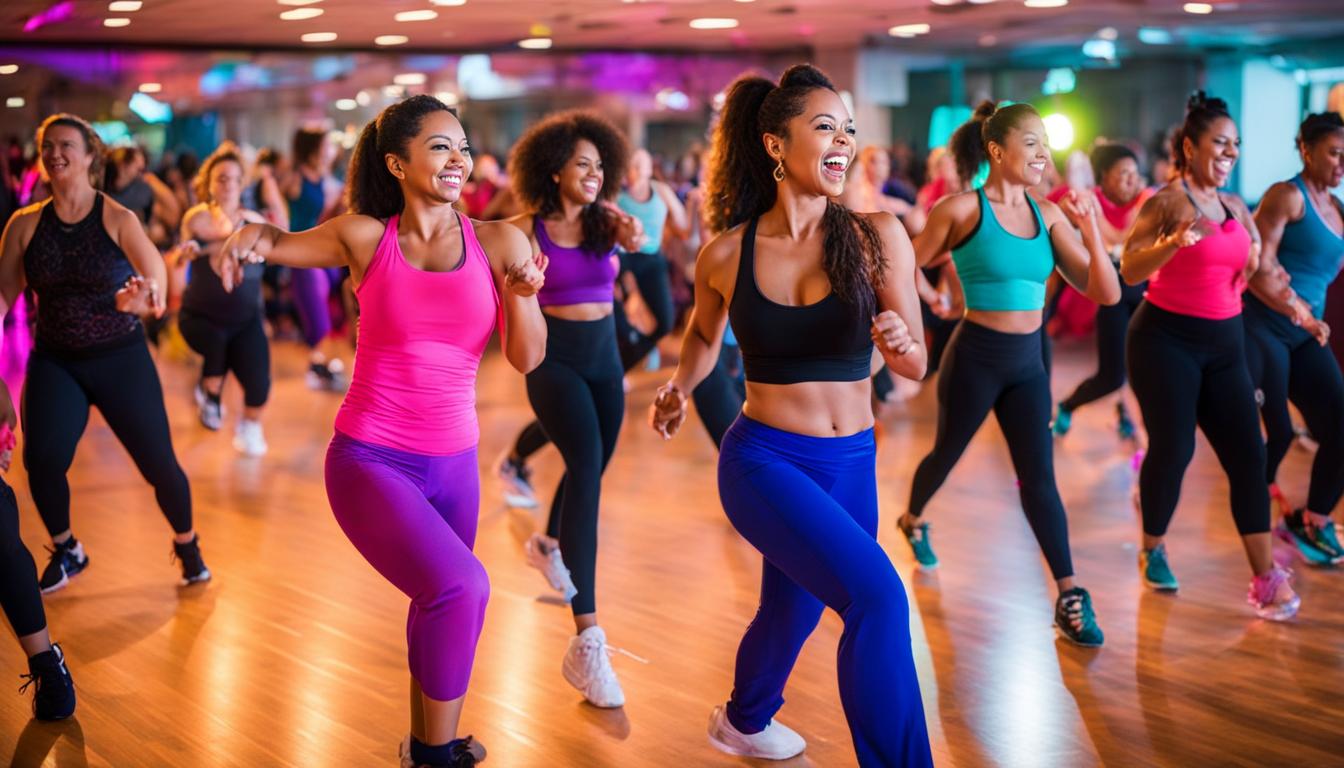Losing weight and maintaining a healthy lifestyle becomes more challenging as we age. However, with the right workouts, it is possible to boost metabolism and burn fat effectively (see my post here). In this guide, we will explore tailored fat-burning workouts specifically designed for individuals over 50. These workouts have been proven to help thousands of men and women in their fitness journey and can provide the results you are looking for.
Key Takeaways:
- Strength training is crucial for weight loss and maintaining muscle mass.
- High-intensity interval training (HIIT) is an effective way to boost metabolism.
- Flexibility and mobility exercises are essential for injury prevention.
- Men over 50 should focus on full-body strength training workouts.
- Women over 50 can benefit from low-impact HIIT exercises.
The Importance of Strength Training for Weight Loss
Strength training is an essential component of any weight loss program, especially for individuals over 50. As we age, we naturally lose lean muscle mass, which can slow down our metabolism. By incorporating strength training into your exercise routine, you can build and preserve muscle, increase calorie burn, and boost your metabolism.
It is crucial to focus on full-body strength training workouts that target all muscle groups. Compound exercises such as squats, deadlifts, shoulder presses, and bench presses are highly effective in building muscle and promoting weight loss.
The Benefits of Strength Training
Strength training offers numerous benefits for older adults looking to lose weight. Here are some of the key advantages:
- Increased Muscle Mass: Strength training helps build and preserve muscle mass, which is essential for burning calories and maintaining a healthy weight.
- Improved Metabolic Rate: Building muscle increases your metabolic rate, allowing you to burn more calories, even at rest.
- Enhanced Bone Health: Strength training stimulates bone growth and improves bone density, reducing the risk of osteoporosis.
- Increased Strength and Balance: Building muscle enhances overall strength and stability, reducing the risk of falls and injuries.
Incorporating strength training into your exercise routine is vital for long-term weight loss and overall health. It is recommended to consult with a fitness professional to design a personalized strength training program that suits your needs and abilities.
High-Intensity Interval Training (HIIT) for Metabolism Boost
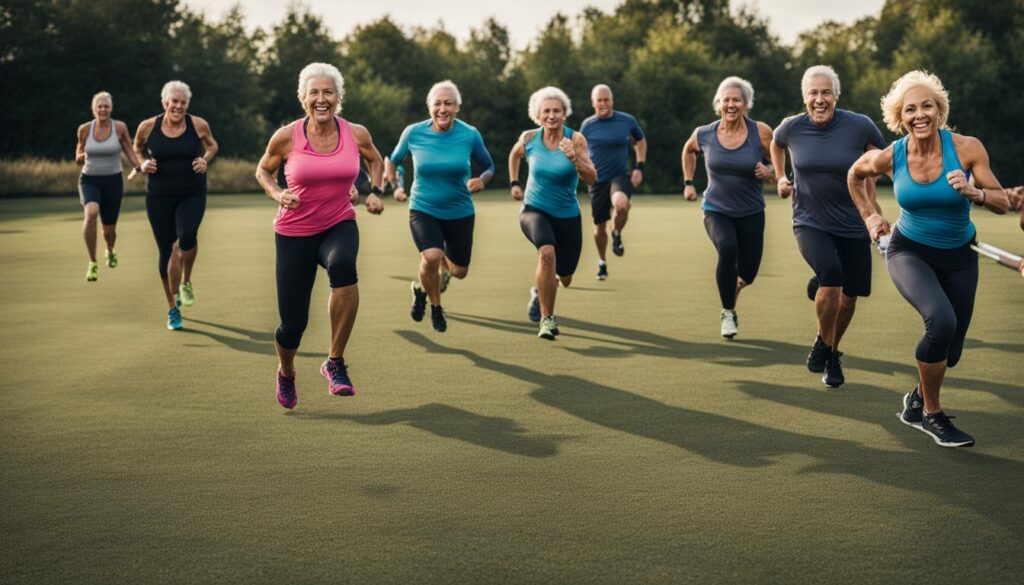
High-Intensity Interval Training (HIIT) is a highly effective workout method for individuals over 50 who want to boost their metabolism and burn fat. HIIT involves alternating between short bursts of intense exercise and periods of active recovery. This type of workout not only increases calorie burn during the workout but also has a long-lasting effect on metabolism, keeping it elevated after the workout is finished.
For older adults, low-impact HIIT exercises are recommended to minimize the risk of injury while still reaping the benefits of HIIT. Walking on a steep incline treadmill or using the elliptical machine are great options for low-impact HIIT. These exercises provide the necessary intensity to stimulate the metabolism while being gentle on the joints.
One of the key advantages of HIIT is its time efficiency. Older adults often have busy schedules, and HIIT allows them to get an effective workout in a shorter amount of time. With the flexibility to adjust the duration and intensity of the intervals, HIIT can be tailored to the individual’s fitness level and goals.
Incorporating HIIT into your fitness program can have significant benefits, including:
- Increased calorie burn
- Improved cardiovascular fitness
- Elevated metabolism
- Reduced body fat
- Preservation of lean muscle mass
The Science Behind HIIT
HIIT works by challenging the cardiovascular system and engaging the body’s anaerobic energy systems. The high-intensity intervals push your heart rate up, improving cardiovascular endurance and increasing calorie burn during the workout. The active recovery periods allow the body to partially recover, setting the stage for the next intense interval.
Studies have shown that HIIT can significantly improve insulin sensitivity, making it a valuable tool for individuals over 50 who may be at a higher risk of insulin resistance and metabolic disorders. The increased metabolic rate induced by HIIT also promotes fat loss and can contribute to weight management.
“High-Intensity Interval Training is a game-changer for individuals over 50 who want to rev up their metabolism and shed unwanted pounds. The short bursts of intense exercise followed by active recovery not only burn calories during the workout but also have a lasting effect on metabolism, making it a highly efficient option for weight loss.”
Benefits of HIIT for Individuals Over 50
1. Weight Loss: HIIT helps optimize fat burning and can lead to significant weight loss when combined with proper nutrition.
2. Improved Cardiovascular Health: The intense intervals challenge the cardiovascular system, improving heart health and endurance.
3. Increased Strength and Muscle Tone: The explosive nature of HIIT exercises can help build strength and improve muscle tone.
4. Enhanced Metabolism: HIIT keeps the metabolism elevated long after the workout, supporting weight management and fat loss.
5. Time Efficiency: HIIT workouts can be completed in less time compared to traditional steady-state cardio exercises.
Sample HIIT Workout for Individuals Over 50
| Exercise | Duration | Intensity | Recovery |
|---|---|---|---|
| Warm-up: Brisk Walking | 5 minutes | Low | N/A |
| Sprint Intervals: Treadmill | 30 seconds | High | 60 seconds |
| Active Recovery: Walking | 60 seconds | Low | N/A |
| Sprint Intervals: Stationary Bike | 30 seconds | High | 60 seconds |
| Active Recovery: Slow Cycling | 60 seconds | Low | N/A |
| Sprint Intervals: Elliptical | 30 seconds | High | 60 seconds |
| Cool-down: Stretching | 5 minutes | Low | N/A |
Note: Customize the duration, intensity, and recovery periods based on your fitness level and consult with a healthcare professional before starting any new exercise program.
Incorporating HIIT into your fitness routine can provide a refreshing change of pace and deliver excellent results for individuals over 50. Remember to listen to your body, gradually increase intensity, and prioritize proper form to ensure a safe and effective workout.
The Role of Flexibility and Mobility for Injury Prevention
As we age, maintaining flexibility and mobility becomes increasingly important for preventing injury and enjoying an active lifestyle. Incorporating targeted flexibility exercises into your workout routine can help improve joint health, reduce aches and pains, and enhance overall mobility. By prioritizing flexibility and mobility, you can ensure an injury-free fitness journey as you age.
The Benefits of Flexibility Exercises for Seniors
- Improved joint health and range of motion
- Reduced muscle tension and stiffness
- Enhanced balance and coordination
- Prevention of common injuries and falls
To maximize the benefits, it is recommended to include both dynamic and static flexibility exercises in your routine. Dynamic flexibility exercises, such as arm swings and hip rotations, are best performed as a warm-up before your workout. These exercises help prepare your muscles and joints for movement, increasing blood flow and flexibility.
After your workout, incorporating static flexibility exercises can further improve flexibility and promote relaxation. Hold each stretch for 15-30 seconds, focusing on major muscle groups such as the hamstrings, quadriceps, chest, shoulders, and back. Examples of static exercises include standing toe touches, seated forward bends, and standing quadricep stretches.
Flexibility exercises play a critical role in preventing injury and maintaining mobility as we age. These exercises not only help us stay active but also contribute to our overall well-being and quality of life.
Senior Fitness Routines for Injury Prevention
When designing a senior fitness routine, it is important to consider exercises that promote flexibility and mobility. Here is an example of a senior fitness routine that prioritizes injury prevention:
| Exercise | Duration | Repetitions |
|---|---|---|
| Arm Swings | 1 minute | 10-15 swings |
| Leg Swings | 1 minute | 10-15 swings per leg |
| Seated Forward Bend | 30 seconds | 2-3 stretches |
| Standing Quadricep Stretch | 30 seconds per leg | 2-3 stretches |
| Standing Chest Stretch | 30 seconds | 2-3 stretches |
Remember to always listen to your body and start with exercises that are appropriate for your fitness level. As you progress, you can gradually increase the intensity and duration of your flexibility exercises.
By incorporating flexibility and mobility exercises into your senior fitness routine, you can improve your overall quality of life, minimize the risk of injury, and maintain an active and independent lifestyle well into your later years.
Strength Training Workouts for Men Over 50
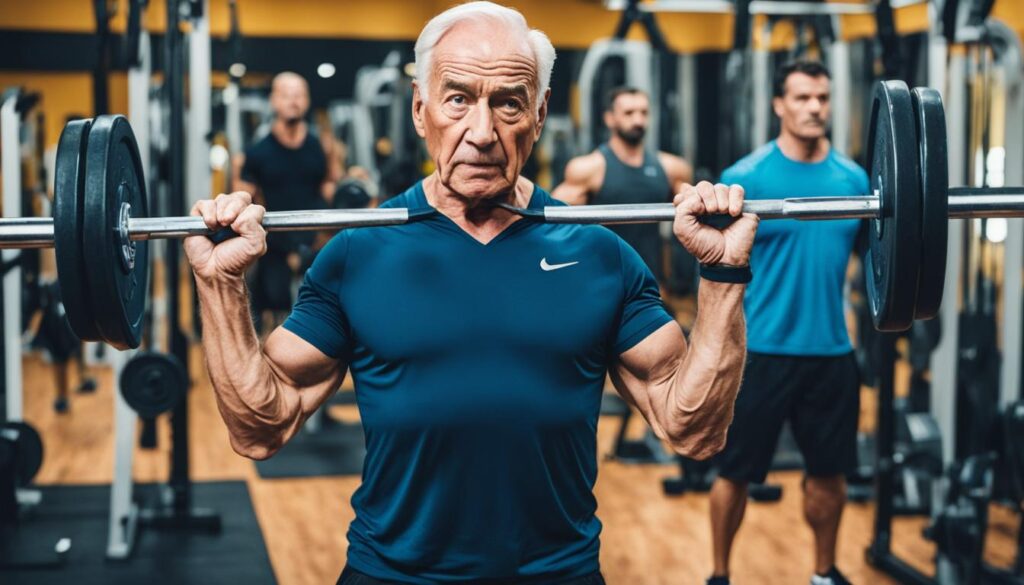
Strength training is a highly effective form of exercise for men over 50 looking to lose weight and improve their overall health. It not only helps preserve muscle mass but also increases bone density and promotes a healthy body composition. To maximize weight loss and achieve optimal results, men over 50 should incorporate full-body strength training workouts that engage all major muscle groups.
Here are some key exercises that should be included in a strength training routine for men over 50:
- Squats: This compound exercise targets the legs, glutes, and core, helping to build lower body strength.
- Deadlifts: Deadlifts work multiple muscle groups, including the back, legs, and core, promoting overall strength and stability.
- Bench Presses: Bench presses target the chest, shoulders, and triceps, contributing to upper body strength and muscle development.
- Overhead Presses: This exercise focuses on the shoulders and arms, improving upper body strength and posture.
It is crucial to perform these exercises with proper form and technique to prevent injury and ensure maximum results. Additionally, men over 50 should gradually increase resistance over time to continue challenging their muscles and promoting growth.
The Benefits of Strength Training for Weight Loss
Incorporating strength training into a weight loss journey offers several benefits specific to men over 50. These include:
- Preservation of Muscle Mass: As we age, our bodies naturally lose muscle mass. Strength training helps preserve and even increase muscle mass, which is essential for maintaining a healthy metabolism. The more lean muscle you have, the more calories you burn, even at rest.
- Increase in Bone Density: Osteoporosis and bone loss are common concerns for men over 50. Strength training exercises like squats and deadlifts help increase bone density and reduce the risk of fractures and osteoporosis.
- Promotion of Overall Health: Strength training offers numerous health benefits, including improved cardiovascular health, enhanced cognitive function, and reduced risk of chronic conditions such as heart disease, diabetes, and certain types of cancer.
By incorporating these strength training exercises into your routine, you can optimize weight loss, improve muscle tone, and enhance overall health and well-being. Remember to consult with a healthcare professional or certified trainer before starting any new exercise program.
“Strength training is a game-changer for men over 50. It not only helps with weight loss but also improves overall strength, bone density, and overall health.”
| Exercise | Targeted Muscle Groups |
|---|---|
| Squats | Legs, glutes, core |
| Deadlifts | Back, legs, core |
| Bench Presses | Chest, shoulders, triceps |
| Overhead Presses | Shoulders, arms |
High-Intensity Interval Training (HIIT) for Women Over 50

High-Intensity Interval Training (HIIT) is an effective workout method for women over 50 who want to burn fat and improve cardiovascular fitness. HIIT involves short bursts of intense exercise followed by periods of active recovery, making it a time-efficient and highly effective way to boost metabolism and burn calories. Not only does HIIT help with weight loss, but it also enhances endurance, increases overall fitness levels, and improves heart health.
For women over 50, low-impact HIIT exercises are particularly beneficial in minimizing the impact on joints while still reaping the benefits. Some low-impact HIIT exercises include elliptical sprints, swimming, or cycling. These exercises provide the necessary intensity to elevate heart rate and challenge the cardiovascular system, without putting excessive stress on the joints.
One of the advantages of HIIT is its versatility. It can be adapted to suit different fitness levels and preferences. Whether you’re a beginner or have prior experience with HIIT, there are various ways to incorporate this training method into your fitness routine. It’s important to listen to your body and start at a pace that is comfortable for you, gradually increasing the duration and intensity of the high-intensity intervals over time.
The Benefits of HIIT for Women Over 50
1. Efficient and time-saving: HIIT workouts typically last for shorter durations compared to traditional cardio exercises while delivering similar or even superior results. This makes them convenient for busy women over 50 who want to maximize their workout efficiency.
2. Increased metabolism: HIIT stimulates the metabolism, promoting calorie burn not only during the workout but also in the hours following the session. This metabolic boost can aid in weight loss and weight management.
3. Enhanced cardiovascular fitness: HIIT workouts challenge the heart and lungs, improving cardiovascular endurance and overall fitness. Regular HIIT sessions can contribute to a healthier heart and a reduced risk of cardiovascular diseases.
4. Preservation of muscle mass: As women age, the loss of muscle mass becomes a common concern. HIIT workouts help preserve muscle mass by engaging multiple muscle groups and promoting muscle growth, which can assist in maintaining strength and preventing muscle loss.
Overall, HIIT offers a multitude of benefits for women over 50 who are looking to lose weight and improve their fitness levels. By incorporating low-impact HIIT exercises into their workout routines, women can enjoy an effective and time-efficient way to burn calories, boost metabolism, and achieve their weight loss goals.
| Benefits of HIIT for Women Over 50 | Description |
|---|---|
| Efficient and time-saving | HIIT workouts deliver similar or superior results in shorter durations, making them convenient for busy women. |
| Increased metabolism | HIIT stimulates the metabolism, promoting calorie burn during and after the workout. |
| Enhanced cardiovascular fitness | HIIT challenges the cardiovascular system, improving endurance and reducing the risk of cardiovascular diseases. |
| Preservation of muscle mass | HIIT engages multiple muscle groups, promoting muscle growth and preventing muscle loss. |
Flexibility and Mobility Exercises for Older Adults

Flexibility and mobility exercises are crucial for older adults to maintain joint health, prevent injury, and improve overall mobility. It’s essential to incorporate these exercises into your workout routine, both as a warm-up before exercising and as part of the cool-down. By regularly practicing flexibility and mobility exercises, you can enjoy an improved range of motion, reduced discomfort, and increased flexibility.
Warm-Up Exercises:
Before starting your workout, it’s important to warm up your muscles and prepare your joints for movement. Here are some effective warm-up exercises for older adults:
- Neck Twists: Gently turn your head from side to side, stretching your neck muscles.
- Shoulder Rolls: Roll your shoulders backward and forward to loosen up your shoulder joints.
- Hip Rotations: Stand with your feet shoulder-width apart and rotate your hips in a circular motion.
- Knee Rotations: Stand straight and lift one knee, then rotate it in a circular motion before switching to the other knee.
- Ankle Rotations: Sit or stand with one leg lifted and rotate your ankle clockwise and counterclockwise.
Cool-Down Exercises:
After your workout, it’s important to cool down and stretch your muscles to improve flexibility and promote recovery. Here are some effective cool-down exercises for older adults:
- Seated Hamstring Stretch: Sit on the edge of a chair with one leg extended, and gently lean forward to stretch the back of your thigh.
- Chest Stretch: Stand upright with your arms extended to the sides, and gently bring them together in front of your chest.
- Calf Stretch: Stand facing a wall, place one foot behind you, and lean forward to stretch the calf muscle of the back leg.
- Quad Stretch: Stand upright, hold onto a chair or wall for support, and bring one heel towards your buttock, stretching the front of your thigh.
- Tricep Stretch: Extend one arm overhead, bend it at the elbow, and gently pull your elbow towards the opposite shoulder to stretch the back of your arm.
| Exercise | Description |
|---|---|
| Neck Twists | Gently turn your head from side to side, stretching your neck muscles. |
| Shoulder Rolls | Roll your shoulders backward and forward to loosen up your shoulder joints. |
| Hip Rotations | Stand with your feet shoulder-width apart and rotate your hips in a circular motion. |
| Knee Rotations | Stand straight and lift one knee, then rotate it in a circular motion before switching to the other knee. |
| Ankle Rotations | Sit or stand with one leg lifted and rotate your ankle clockwise and counterclockwise. |
By incorporating flexibility and mobility exercises into your workout routine, you can improve your overall fitness, prevent injuries, and enhance your quality of life as an older adult.
Effective Exercises for Rapid Weight Loss After 50
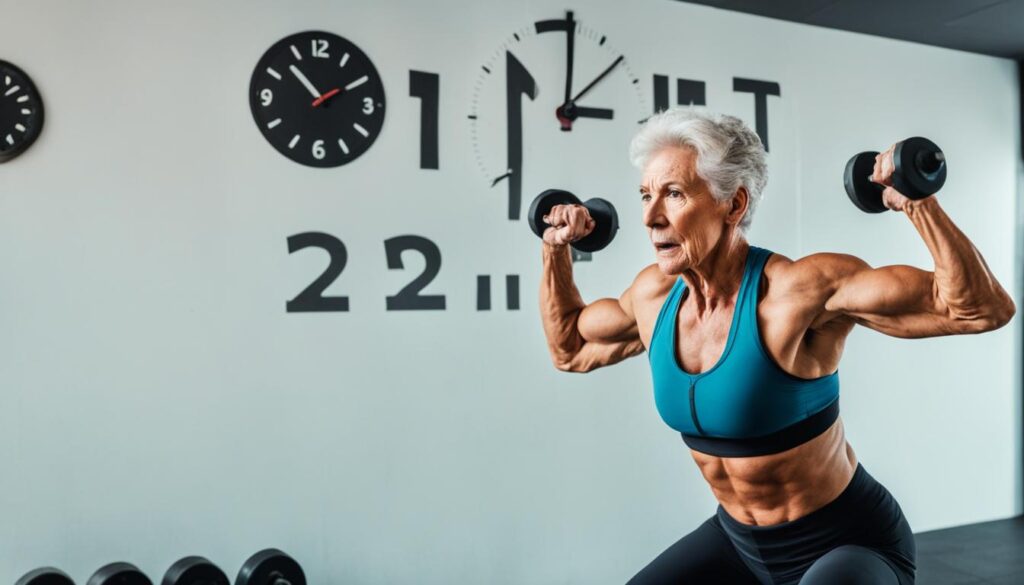
Losing weight can be more challenging as we age, but incorporating the right exercises into your routine can help accelerate weight loss and improve overall fitness. By engaging in a combination of strength training and cardiovascular exercises, you can effectively burn calories, increase muscle tone, and boost your metabolism.
Here are some effective exercises for rapid weight loss after 50:
- Dumbbell Goblet Squats: This exercise targets your lower body, including your quadriceps, hamstrings, and glutes. It also engages your core muscles for stability.
- Dumbbell Rows: This exercise strengthens your back muscles and improves posture. It targets your lats, rhomboids, and rear deltoids.
- Wide Grip Cable Rows: By incorporating wide grip cable rows into your workout, you can effectively target your upper back muscles, including the rhomboids and rear deltoids.
- Dumbbell Thrusters: This compound exercise engages multiple muscle groups, including your quadriceps, glutes, shoulders, and triceps. It is an excellent calorie burner.
- Dumbbell Walking Lunges: Walking lunges help strengthen your legs, including your quadriceps, hamstrings, and glutes. It also improves balance and stability.
- Hack Squats: This exercise primarily targets your quadriceps, but it also works your glutes and hamstrings. It is an effective lower body exercise.
- Leg Presses: Leg presses target your quadriceps, hamstrings, and glutes. It is an excellent exercise for building lower body strength.
- Bulgarian Split Squats: This exercise targets your quads, glutes, and hamstrings, providing a challenging workout for your lower body.
- Kettlebell Deadlifts: Deadlifts help strengthen your posterior chain, including your hamstrings, glutes, and lower back. They are effective for building overall strength.
- Bodyweight Rows: Bodyweight rows engage your back muscles, including your lats and rhomboids. This exercise improves upper body strength and posture.
- Lat Pulldowns: Lat pulldowns strengthen your back muscles, in particular, your latissimus dorsi. It also works your shoulders and biceps.
- Incline Dumbbell Neutral Grip Bench Presses: This exercise targets your chest muscles, shoulders, and triceps. It helps build upper body strength.
- Dumbbell Pushups: Dumbbell pushups are an effective variation of traditional pushups, targeting your chest, shoulders, and triceps.
- Landmine Deadlifts: Landmine deadlifts engage your lower body muscles, including your hamstrings, glutes, and lower back. They are a safe and effective alternative to traditional barbell deadlifts.
- Kettlebell Swings: Kettlebell swings are a full-body exercise that targets your glutes, hamstrings, and core muscles. They provide an excellent cardiovascular workout.
These exercises target multiple muscle groups, promote calorie burn, and enhance muscle tone. Incorporating them into your workout routine can help you achieve rapid weight loss and improve overall fitness.
Remember to consult with a healthcare professional before starting any new exercise program, especially if you have any pre-existing medical conditions or injuries. Additionally, listen to your body and make modifications as necessary to avoid overexertion or injury.
Strength Training and Power Building for Aging Bodies
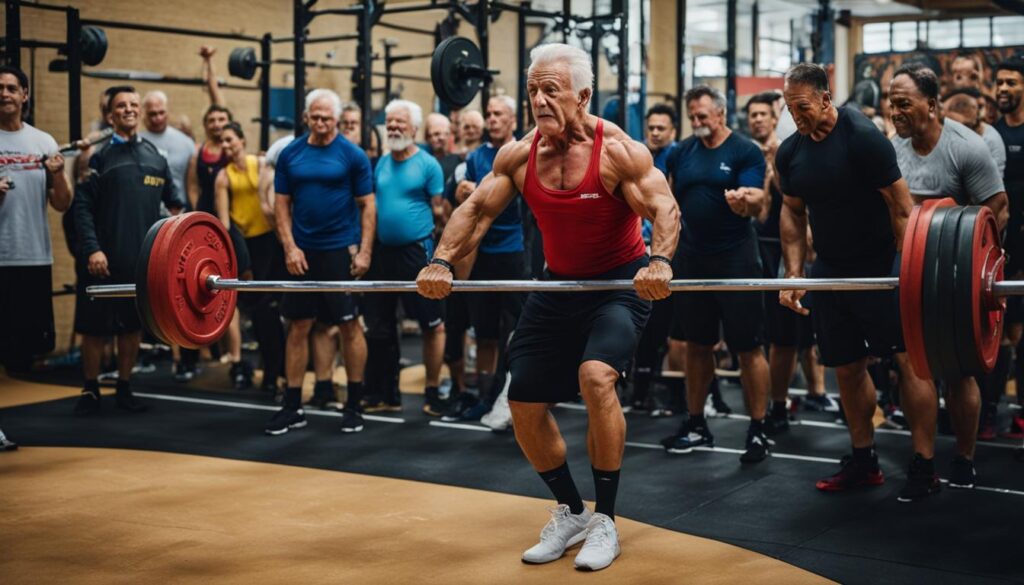
As our bodies age, it becomes even more important to focus on strength training and power building. Strength training helps maintain muscle mass, improve bone density, and boost overall strength. Power training, on the other hand, involves lifting lighter weights explosively, which is particularly beneficial for aging bodies as it enhances muscle power and improves functional fitness.
The Benefits of Strength Training:
- Preserves muscle mass
- Improves bone density
- Boosts overall strength
By incorporating both strength training and power building exercises into your routine, you can maintain muscle mass, improve body composition, and enhance overall physical performance.
| Exercise | Benefits |
|---|---|
| Squats | Engages major muscle groups, improves lower body strength |
| Deadlifts | Targets posterior chain muscles, enhances overall strength |
| Bench Presses | Develops upper body strength, improves chest and tricep muscles |
Incorporating a combination of compound exercises like squats, deadlifts, and bench presses, along with explosive power exercises, can provide effective workouts for aging bodies. Remember to gradually increase resistance and maintain proper form throughout the exercises to maximize results and minimize the risk of injury.
“Strength doesn’t come from what you can do. It comes from overcoming the things you once thought you couldn’t.” – Rikki Rogers
Can the Fat-Burning Workouts for Over 50s be Modified for Office-Friendly Use?
Can fat-burning office workouts be modified for over 50s? Yes! Incorporating exercises such as desk stretches, chair squats, and wall push-ups targets muscle groups while minimizing disruption. These office-friendly modifications help boost metabolism, improve posture, and increase energy levels for a healthier workday. Try adding some movement into your office routine with these fatburning office workouts.
Smart Training Strategies for Older Individuals
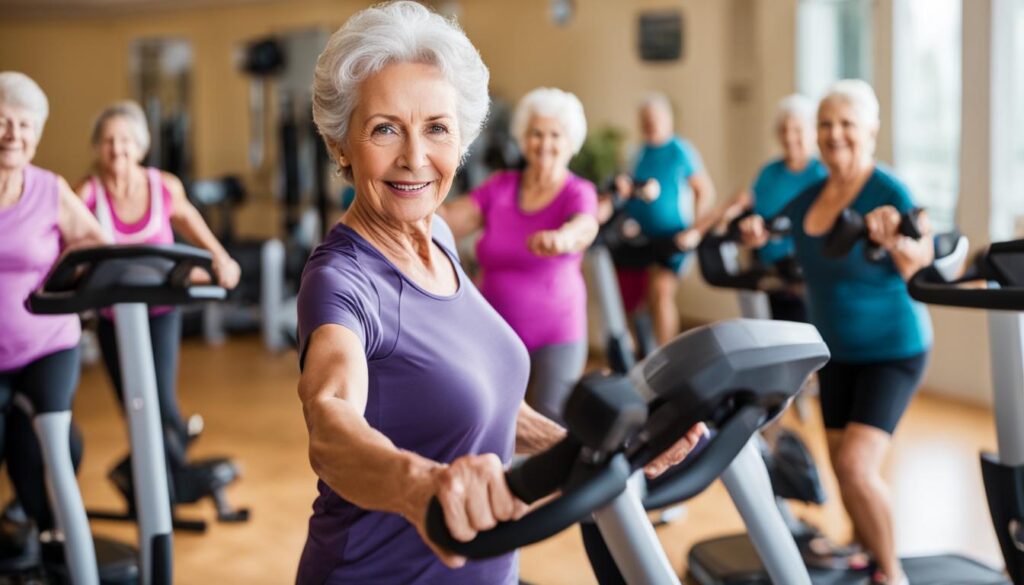
As we age, it becomes essential to adapt our training strategies to maximize results and prevent injury. Older adults have unique needs and considerations when it comes to fitness, and utilizing smart training strategies can help them stay in shape, improve their fitness, and prevent potential setbacks.
Here are some effective fitness strategies for older adults:
1. Use Dumbbells Instead of Barbells
When performing strength training exercises, using dumbbells instead of barbells can provide more comfortable movement and reduce the strain on joints. Dumbbells allow for greater range of motion and provide an opportunity for better control and stability during the exercise.
2. Incorporate Bodybuilding-Style Isolation Exercises
Bodybuilding-style isolation exercises target specific muscle groups and can be beneficial for older adults, as they promote faster recovery and minimize the risk of overexertion. Including exercises such as bicep curls, tricep extensions, and calf raises can help older individuals improve muscle tone and overall strength.
3. Focus on Recovery Time
Recovery is crucial for older adults to prevent injuries and promote overall fitness. Incorporating foam rolling and easy yoga exercises into your routine can help improve flexibility, reduce muscle soreness, and enhance recovery. Giving your body ample time to recover between workout sessions is vital for maintaining optimal performance.
4. Set Limits on Training Sessions
While it’s important to challenge yourself during workouts, it’s equally important to set limits on training sessions to avoid overexertion. Listen to your body and adjust the intensity and duration of your workouts as needed. It’s better to have shorter, more efficient workouts than to risk physical strain or injury.
5. Track Progress and Modify Accordingly
Keep a record of your workouts, including the exercises performed, weights used, and any modifications made. Regularly review your progress and modify your training program accordingly to continue challenging yourself and achieving great results.
By following these smart training strategies, older individuals can continue to enjoy the benefits of regular exercise while reducing the risk of injury. Remember to consult with a healthcare professional or a certified fitness trainer before starting any new exercise program, especially if you have pre-existing health conditions or concerns.
The Role of Nutrition in Weight Loss for Older Adults
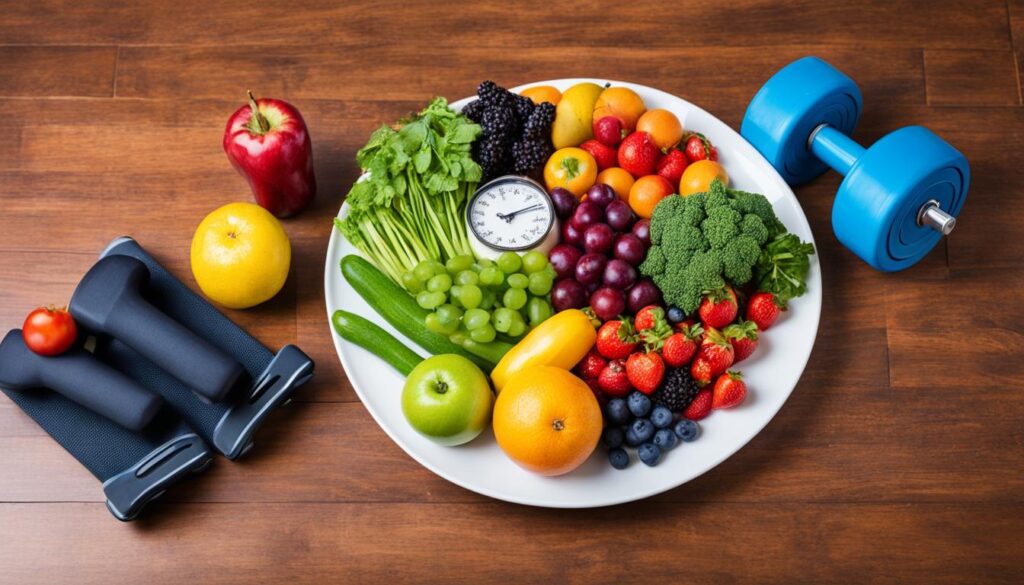
Along with exercise, nutrition plays a crucial role in weight loss for older adults. A healthy and balanced diet that is rich in lean proteins, fruits, vegetables, whole grains, and healthy fats is recommended. It is also important to pay attention to portion sizes, stay hydrated, and limit processed and sugary foods. By combining a nutritious diet with regular exercise, older adults can achieve sustainable weight loss and improve overall health and well-being.
When it comes to nutrition for weight loss in older adults, a focus on nutrient-dense foods is essential. Lean proteins, such as lean meats, poultry, fish, eggs, and low-fat dairy products, provide important amino acids for muscle maintenance and repair. Fruits and vegetables are packed with vitamins, minerals, and antioxidants that support cellular health and boost immune function. Whole grains, like whole wheat bread, brown rice, and oats, are high in fiber and provide sustained energy. Healthy fats, such as avocados, nuts, seeds, and olive oil, contribute to satiety and support brain health.
Portion control is particularly important for older adults who may have a slower metabolism. Eating smaller, frequent meals throughout the day can help maintain steady blood sugar levels and prevent overeating. It is also essential to stay properly hydrated by drinking water throughout the day. Dehydration can lead to fatigue, confusion, and a slowed metabolism.
Avoiding processed and sugary foods is crucial for weight loss and overall health. These foods are often high in added sugars, unhealthy fats, and salt, while lacking essential nutrients. Opt for whole, unprocessed foods whenever possible and limit your intake of sugary beverages, sweets, and snacks. Instead, satisfy your sweet tooth with naturally sweet foods like fruits.
Finally, it is important to seek guidance from a healthcare professional or registered dietitian who can provide personalized nutrition recommendations based on your individual needs and goals. They can help create a customized meal plan that takes into account any specific dietary restrictions or health conditions.
Remember, achieving weight loss in older adults is not just about the number on the scale. It’s about improving overall health, maintaining muscle mass, and promoting longevity. By adopting a healthy diet and incorporating regular exercise, you can achieve sustainable weight loss and enjoy a healthier, happier life.
| Nutrient-Dense Foods | Avoid |
|---|---|
| Lean proteins (lean meats, poultry, fish, eggs, low-fat dairy products) | Processed foods |
| Fruits and vegetables | Sugary beverages |
| Whole grains (whole wheat bread, brown rice, oats) | Sweets and snacks |
| Healthy fats (avocados, nuts, seeds, olive oil) |
Table: Nutrient-Dense Foods to Include and Foods to Avoid for Weight Loss in Older Adults
Conclusion
Staying fit and maintaining a healthy lifestyle is achievable for individuals over 50 with the right workouts and lifestyle choices. By incorporating strength training, high-intensity interval training (HIIT), flexibility and mobility exercises, and smart training strategies, older adults can improve their fitness, boost metabolism, burn fat, and prevent injury.
Regular exercise is key to staying fit after 50. Incorporating strength training exercises, such as squats, deadlifts, and bench presses, helps build and preserve muscle, increase calorie burn, and improve overall strength. HIIT workouts, like walking on a steep incline or using the elliptical machine, offer a time-efficient way to elevate metabolism and burn calories.
Flexibility and mobility exercises are crucial to maintain joint health and prevent injury. Including dynamic stretches before working out and static stretches after can improve range of motion and reduce discomfort. By following smart training strategies, such as using dumbbells for comfortable movement and incorporating recovery techniques like foam rolling, older adults can optimize their workouts and prevent overexertion.
Combining these workouts with a nutritious diet is essential for optimal fitness. A diet rich in lean proteins, fruits, vegetables, whole grains, and healthy fats supports weight loss and overall health. Listening to your body’s needs and prioritizing self-care are also key to success. With dedication and the right guidance, individuals over 50 can maintain a healthy weight, increase energy levels, and enjoy an active and fulfilling life.

